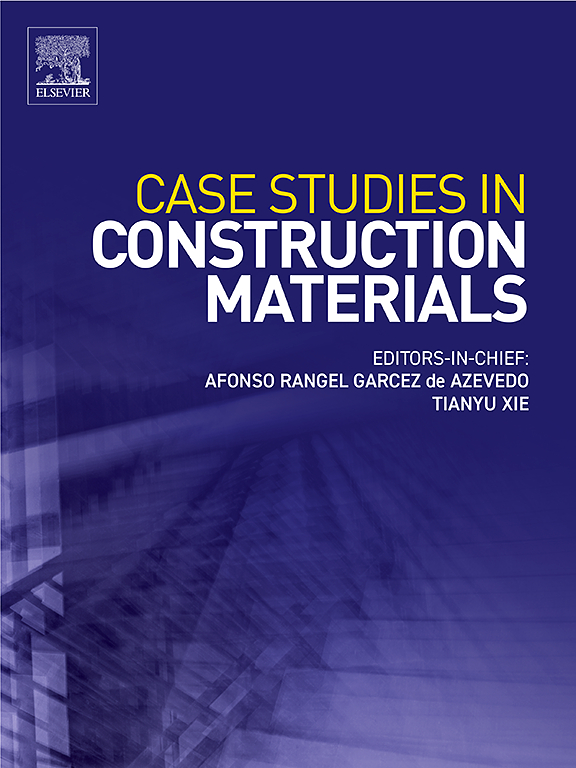Cr-Mo合金钢筋在模拟孔隙溶液和真实海水海砂混凝土中的耐蚀性初步研究
IF 6.6
2区 工程技术
Q1 CONSTRUCTION & BUILDING TECHNOLOGY
引用次数: 0
摘要
钢筋混凝土结构中预埋钢筋的腐蚀大大降低了结构的使用寿命,甚至导致结构的早期失效。本研究旨在探讨CR - mo合金钢筋(CR)在海水海砂混凝土(SWSSC)中的耐腐蚀机理及其在海水海砂混凝土中的应用可能性。对三种型钢进行了实际SWSSC和海水海砂混凝土孔隙溶液(SWSSCPS)试验。与低碳钢(LC)和不锈钢(SS)相比,采用电化学、原子力显微镜(AFM)、XPS和SEM-EDS等方法研究了钝化膜的组成、结构和形貌特征。电化学分析表明,在浸泡初期,CR的耐腐蚀性能表现出开路电位和电化学阻抗谱(EIS)的快速增加,表明其存在一个主动-被动过渡过程。CR表面钝化膜具有明显的元素分布,其中铬和铁对增强其稳定性起着至关重要的作用。基于钢-混凝土和钢-溶液界面处的腐蚀产物与钝化膜的相互作用,提出了钝化膜形成的可能性和CR的抵抗机理。本研究大大增加了对SWSSC中CR耐腐蚀特性的理解。此外,它为其优化利用提供了宝贵的观点,这有利于促进海洋和沿海地区钢筋混凝土结构的发展。本文章由计算机程序翻译,如有差异,请以英文原文为准。
Insights into the corrosion resistance of Cr-Mo alloy reinforcing steel in simulated pore solution and real seawater sea-sand concrete: A preliminary study
Corrosion of steel bars embedded in reinforced concrete structures considerably reduces the service life and even causes early failure of the structure. The purpose of this study is to investigate the corrosion resistance mechanism of Cr-Mo alloy reinforcing steel (CR) in seawater sea-sand concrete (SWSSC) and the possibility of its application in SWSSC. Three types of steel were carried out in real SWSSC and seawater sea-sand concrete pore solution (SWSSCPS). Compared with low-carbon steel (LC) and stain-less steel (SS), electrochemical measurements, AFM, XPS and SEM-EDS were applied to study the composition, structure and morphology characterizations of passive film. Electrochemical analysis revealed that in the initial stage of immersion, the corrosion resistance of CR demonstrated a rapid increase in open-circuit potential and electrochemical impedance spectroscopy (EIS), suggesting an active-passive transition process. The passive film on CR was found to have a distinct elemental distribution, with chromium and iron playing crucial roles in enhancing its stability. Based on the interactions of steel corrosion products and passive film at the steel-concrete and steel-solution interface, the possible formation of passive film and the resistance mechanism of CR were proposed. This study substantially augments the comprehension of the corrosion resistance characteristics of CR within SWSSC. Moreover, it proffers invaluable perspectives for the optimization of its utilization, which is conducive to fostering the advancement of reinforced concrete structures in marine and coastal zones.
求助全文
通过发布文献求助,成功后即可免费获取论文全文。
去求助
来源期刊

Case Studies in Construction Materials
Multiple-
CiteScore
7.60
自引率
19.40%
发文量
842
审稿时长
63 days
期刊介绍:
Case Studies in Construction Materials provides a forum for the rapid publication of short, structured Case Studies on construction materials. In addition, the journal also publishes related Short Communications, Full length research article and Comprehensive review papers (by invitation).
The journal will provide an essential compendium of case studies for practicing engineers, designers, researchers and other practitioners who are interested in all aspects construction materials. The journal will publish new and novel case studies, but will also provide a forum for the publication of high quality descriptions of classic construction material problems and solutions.
 求助内容:
求助内容: 应助结果提醒方式:
应助结果提醒方式:


